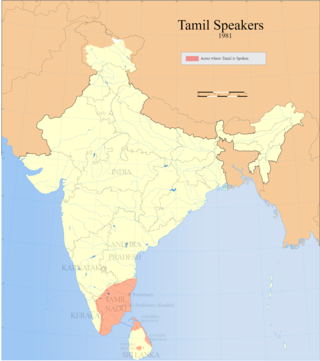Top Qs
Timeline
Chat
Perspective
Tamil numerals
Numeral system From Wikipedia, the free encyclopedia
Remove ads
The Tamil language has number words and dedicated symbols for them in the Tamil script. They have mostly been supplanted by Arabic numerals in common usage.
This article includes a list of general references, but it lacks sufficient corresponding inline citations. (August 2020) |


Remove ads
Basic numbering in Tamil
Zero
Old Tamil possesses a special numerical character for zero (see Old Tamil numerals below), which is read as andru (literally, no/nothing). Modern Tamil words for zero include சுழியம் (suḻiyam) or பூஜ்ஜியம் (pūjjiyam).
First ten numbers (முதல் எண்கள்)
Remove ads
Transcribing other numbers
Summarize
Perspective
Reproductive and attributive prefixes
Tamil has a numeric prefix for each number from 1 to 9, which can be added to the words for the powers of ten (ten, hundred, thousand, etc.) to form multiples of them. For instance, the word for fifty, ஐம்பது (aimpatu) is a combination of ஐ (ai, the prefix for five) and பத்து (pattu, which is ten). The prefix for nine changes with respect to the succeeding base 10. தொ + the unvoiced consonant of the succeeding base 10 forms the prefix for nine. For instance, 90 is தொ + ண் (ண் being the unvoiced version of ணூ), hence, தொண்ணூறு).
These are typically void in the Tamil language except for some Hindu references; for example, அட்ட இலட்சுமிகள் (the eight Lakshmis). Even in religious contexts, the Tamil language is usually more preferred for its more poetic nature and relatively low incidence of consonant clusters.
Specific characters
Unlike other modern Indian number systems, Tamil has distinct digits for 10, 100, and 1000. It also has distinct characters for other number-based aspects of day-to-day life.
Powers of ten (பதின்பெருக்கம்)
There are two numeral systems that can be used in the Tamil language: the Tamil system which is as follows[2] [clarification needed]
The following are the traditional numbers of the Tamiḻakam region.[clarification needed]
Original Tamil system
Current Tamil system
Partitive numerals (பகுத்தல்)
Fractions (பின்னம்)
Proposals to encode Tamil fractions and symbols to Unicode were submitted.[3][4] As of version 12.0, Tamil characters used for fractional values in traditional accounting practices were added to the Unicode Standard.
Transcribing fractions (பின்னம் எழுத்தல்)
Any fraction can be transcribed by affixing -இல் (-il) after the denominator followed by the numerator. For instance, 1/41 can be said as நாற்பத்து ஒன்றில் ஒன்று (nāṟpattu oṉṟil oṉṟu).
The suffixing of the -இல் (-il) requires the last consonant of the number to be changed to its இ (i) form. For example, மூன்று + இல் (mūṉṟu + -il) becomes மூன்றில் (mūṉṟil); note the உ (u) has been omitted.
Common fractions (பொது பின்னங்கள்) have names already allocated to them, hence, these names are often used rather than the above method.
^ when prefixed to a fraction, reduces (downscales) the value of the fraction by a scale of 1/320 (the value of the lowest fraction muntiri).
Other fractions include:
^ Aṇu was considered as the lowest fraction by ancient Tamils as size of smallest physical object (similar to an atom). Later, this term went to Sanskrit to refer directly to atoms.[citation needed]
Decimals (பதின்மம்)
Decimal point is called புள்ளி (puḷḷi) in Tamil. For example, 1.1 would be read as ஒன்று புள்ளி ஒன்று (oṉṟu puḷḷi oṉṟu). In Sri Lankan Tamil, Thasam தசம்.
Percentage (விழுக்காடு)
Percentage is known as விழுக்காடு (viḻukkāḍu) in Tamil or சதவீதம் (śatavītam). These words are simply added after a number to form percentages. For instance, four percent is நான்கு சதவீதம் (nāṉku satavītam) or நான்கு விழுக்காடு (nāṉku viḻukkāḍu). Percentage symbol (%) is also recognised and used.
Ordinal numbers (வரிசை எண்கள்)
Ordinal numbers are formed by adding the suffix -ஆம் (ām) after the number, except for 'First'.
Collective numerals (கூட்டெண்கள்)
- As always, when blending two words into one, an unvoiced form of the consonant as the one that the second starts with, is placed in between to blend.
Remove ads
Traditional Tamil counting song
Summarize
Perspective
This song is a list of each number with a concept its primarily associated with.
Influence on other Dravidian languages
As the ancient classical Dravidian language, Tamil numerals influenced and shaped the numerals of the others in the family. The following table compares the main Dravidian languages.
Also, Tamil through the Pallava script which itself through the Kawi script, Khmer script and other South-east Asian scripts has shaped the numeral grapheme of most South-east Asian languages.
Remove ads
History
Before the Government of India unveiled ₹ as the new rupee symbol, people in Tamil Nadu used the Tamil letter ௹ as the symbol. This symbol continues to be used occasionally as rupee symbol by Indian Tamils. It is also used by Tamils in Sri Lanka.
The symbol ௳ is also known as the Piḷḷaiyār Suḻi (lit. 'Curl of Piḷḷaiyār'), a symbol that most Tamil Hindus will start off any auspicious document with. It is written to invoke the god Piḷḷaiyār, known otherwise as Ganesha, who is the remover of obstacles.
Remove ads
See also
References
Wikiwand - on
Seamless Wikipedia browsing. On steroids.
Remove ads
